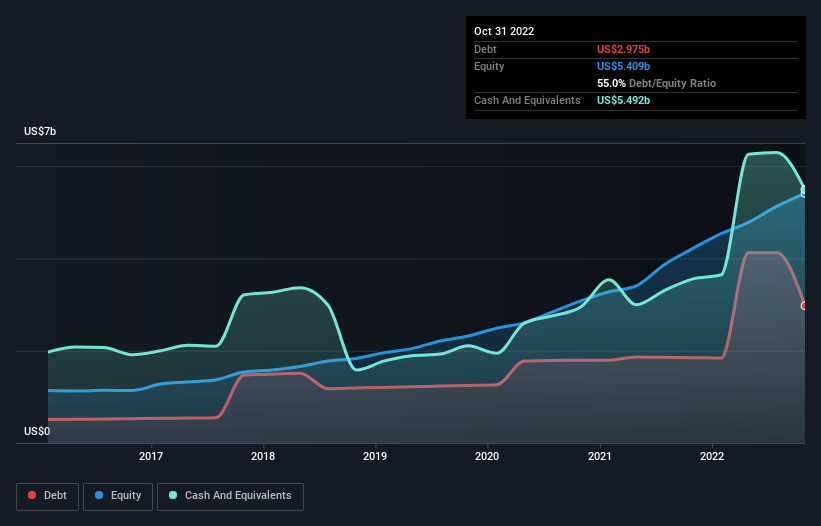Health Check: How Prudently Does Workday (NASDAQ:WDAY) Use Debt?
Some say volatility, rather than debt, is the best way to think about risk as an investor, but Warren Buffett famously said that 'Volatility is far from synonymous with risk.' So it might be obvious that you need to consider debt, when you think about how risky any given stock is, because too much debt can sink a company. Importantly, Workday, Inc. (NASDAQ:WDAY) does carry debt. But is this debt a concern to shareholders?
When Is Debt Dangerous?
Generally speaking, debt only becomes a real problem when a company can't easily pay it off, either by raising capital or with its own cash flow. In the worst case scenario, a company can go bankrupt if it cannot pay its creditors. However, a more common (but still painful) scenario is that it has to raise new equity capital at a low price, thus permanently diluting shareholders. Of course, debt can be an important tool in businesses, particularly capital heavy businesses. The first thing to do when considering how much debt a business uses is to look at its cash and debt together.
Check out our latest analysis for Workday
What Is Workday's Net Debt?
As you can see below, at the end of October 2022, Workday had US$2.97b of debt, up from US$1.85b a year ago. Click the image for more detail. But on the other hand it also has US$5.49b in cash, leading to a US$2.52b net cash position.
How Strong Is Workday's Balance Sheet?
Zooming in on the latest balance sheet data, we can see that Workday had liabilities of US$3.72b due within 12 months and liabilities of US$3.26b due beyond that. Offsetting these obligations, it had cash of US$5.49b as well as receivables valued at US$1.04b due within 12 months. So its liabilities outweigh the sum of its cash and (near-term) receivables by US$448.1m.
This state of affairs indicates that Workday's balance sheet looks quite solid, as its total liabilities are just about equal to its liquid assets. So while it's hard to imagine that the US$43.1b company is struggling for cash, we still think it's worth monitoring its balance sheet. Despite its noteworthy liabilities, Workday boasts net cash, so it's fair to say it does not have a heavy debt load! When analysing debt levels, the balance sheet is the obvious place to start. But it is future earnings, more than anything, that will determine Workday's ability to maintain a healthy balance sheet going forward. So if you want to see what the professionals think, you might find this free report on analyst profit forecasts to be interesting.
In the last year Workday wasn't profitable at an EBIT level, but managed to grow its revenue by 21%, to US$5.9b. Shareholders probably have their fingers crossed that it can grow its way to profits.
So How Risky Is Workday?
Although Workday had an earnings before interest and tax (EBIT) loss over the last twelve months, it generated positive free cash flow of US$1.2b. So although it is loss-making, it doesn't seem to have too much near-term balance sheet risk, keeping in mind the net cash. One positive is that Workday is growing revenue apace, which makes it easier to sell a growth story and raise capital if need be. But that doesn't change our opinion that the stock is risky. There's no doubt that we learn most about debt from the balance sheet. But ultimately, every company can contain risks that exist outside of the balance sheet. For instance, we've identified 2 warning signs for Workday that you should be aware of.
If, after all that, you're more interested in a fast growing company with a rock-solid balance sheet, then check out our list of net cash growth stocks without delay.
Have feedback on this article? Concerned about the content? Get in touch with us directly. Alternatively, email editorial-team (at) simplywallst.com.
This article by Simply Wall St is general in nature. We provide commentary based on historical data and analyst forecasts only using an unbiased methodology and our articles are not intended to be financial advice. It does not constitute a recommendation to buy or sell any stock, and does not take account of your objectives, or your financial situation. We aim to bring you long-term focused analysis driven by fundamental data. Note that our analysis may not factor in the latest price-sensitive company announcements or qualitative material. Simply Wall St has no position in any stocks mentioned.
Join A Paid User Research Session
You’ll receive a US$30 Amazon Gift card for 1 hour of your time while helping us build better investing tools for the individual investors like yourself. Sign up here

 Yahoo Finance
Yahoo Finance 
